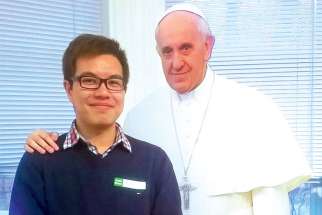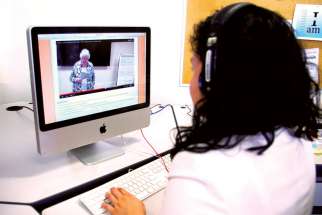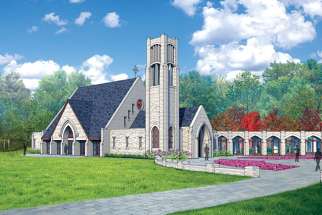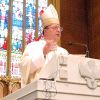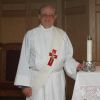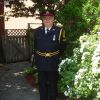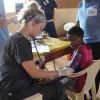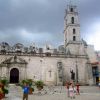Where strangers leave as friends
Earlier this year, I had a “dilemma.” There were five retreats happening in the same month — some landing on the same weekends. Which retreat should I go on? There was a Chinese Catholic students’ retreat, a quad university chaplaincies including my alma mater, one with the University of Toronto, another one on discernment and the silent retreat with the York University chaplaincy. In the end, I chose the days of discernment retreat. Funny enough, I ended up making a decision to go on a retreat to learn how to make better life decisions.
Taking retreats online
For the busy person who can’t get away for a spiritual retreat weekend, all they may need is to turn on their computer.
Virtual retreats are a fairly new concept — a retreat conducted through online media, often based on a time and place of the individual’s choosing.
OMAHA, Neb. - Working to establish and build a business that would become one of the largest discount brokerages in the United States — TD Ameritrade — Joe Ricketts found some 20 years ago he was drifting away from the Catholic faith and values that formed him growing up in Nebraska City.
Food for all

More than 800 million people around the world go hungry every day. In a Catholic Register special report, associate editor Michael Swan examines this human tragedy and takes a look at what some organizations are doing about it. Also included in the package is an article by Cardinal Peter Turkson, president of the Pontifical Council for Justice and Peace. Read all the articles below:
- 'Food is an inalienable right' by Cardinal Peter Turkson
- Farming locally, helping globally
Pastoral plan aims for more Catholic presence on campus
Ryerson’s faithful have a place to call their own
Catholic schools stress faith in recruitment
Each year thousands of high school students seek the next step in their educational journey — and there are plenty of options.
Kahnawake embraces Kateri’s spirit
KAHNAWAKE, QUE. - The small Catholic community of St. Francis Xavier Church, with the St. Lawrence River and sprawling Montreal as its backdrop, has enthusiastically prepared for the canonization of Blessed Kateri Tekakwitha.
Located in Mohawk territory in Kahnawake, the church enshrines the remains of Blessed Kateri, a native woman who found refuge and spiritual renewal in the region where she spent her final days as a Catholic. Her remains lay beneath a marble tomb in the church, entombed primarily to ensure their safety and respect, as someone had previously attempted to steal them many years ago.
Pilgrims can kneel and pray or light a votive candle with Blessed Kateri’s likeness on it. The image is based on an oil-on-canvas painting, housed in a room beyond the gift shop, painted by Jesuit Father Claude Chauchetiere, the pastor of St. Francis Xavier Mission from 1677 to 1688, and a witness at Blessed Kateri’s death.
In a gift shop adjacent to the church, Kahnawake native Ann-Marie Sky talks about the importance of Blessed Kateri’s example not only for herself, but for the survival of the parish.
“For me, it’s her spirituality and her perseverance during the time and after she became Catholic. She was ostracized for that, so her faith really carried her through,” Sky said. Similarly, the parish has had to learn to persevere just to keep the church doors open.
“The church almost had to close a year and a half ago due to finances,” Sky explained. “We were just working our way back up and we got the news that she will be canonized, so now we’re really trying to keep the church afloat.”
For a parish that only sees about 60 regular Mass-goers on Sunday mornings, the annual $25,000 price tag for utilities to heat and use the church has been a challenge. But with great faith and ambitious fundraisers, it has managed to pay the bills. And since the announcement that Kateri would be canonized on Oct. 21, making her the first North American aboriginal saint, the parish has seen nearly three times the number of pilgrims it normally sees. The demand for Kateri merchandise has risen and Sky is trying to stock enough merchandise before Oct. 21, when the mission expects busloads of visitors to join parishioners for a re-broadcast of the canonization in Rome.
The Pope’s Feb. 18 announcement of Kateri’s canonization came as a surprise.
“I couldn’t believe it, because after Brother André was canonized, I didn’t think there would be anybody else from Quebec canonized for another 20 years,” Sky said.
And not only in Quebec, but from the same area, she added. From the church in Kahnawake, the dome of St. Joseph’s Oratory on Mount Royal — the legacy of St. Brother André — is easy to spot across the river on a clear day.
Like Sky, Kahnawake resident Beverly Delormier has been working diligently to prepare for the big day, although Delormier will be spending it in Rome.
“I was there in 1980 with my daughters when she was beatified and never in my wildest dreams did I think that I would go there again for the canonization,” marvelled Delormier. “The day of the beatification everybody had their native dress on, so it was really something spectacular to see.”
For Delormier, Blessed Kateri is an important intercessor.
“It’s all little things, but I believe in the power of prayer.”
Deacon Ron Boyer, Canadian vice-postulator for the canonization of Kateri, says her canonization is long overdue. But more importantly, the canonization brings to light God’s desire to reach the aboriginal people.
“Her first miracle happened about 15 minutes after she died,” Boyer said, referring to the historical accounts of Kateri’s transformation. Kateri had contracted smallpox as a child and was left partially blind and covered with facial scars. Minutes after her death, any trace of her scars vanished and her appearance was described as beautiful.
“Why would God glorify a dead body? Why? Nobody has been able to answer that for me, but I believe He did it to show us that there is a God,” Boyer concludes.
Boyer adds Kateri is also significant for her impact on Christians and non-Christians alike.
“Many non-Catholic aboriginal people are going to Rome to pay homage to Kateri. She was special, a lady of many qualities,” Boyer said. “She is also the empress of ecology and a symbol for the youth.”
As the diocese of Saint-Jean- Longueuil is not immune to the shortage of priests in Canada, St. Francis Xavier has a pastor, Fr. Raymond Esprit, who is present only three days per week. Boyer hopes the canonization and increased traffic might mean a permanent priest in the future.
In the meantime, the canonization has already served to strengthen ties within the Kahnawake community. A committee from the parish has been working with the diocese to prepare for the big day, as well as a thanksgiving Mass to be held at St. Joseph’s Oratory on Nov. 4.
Saint-Jean-Longueuil diocese is sending 200 pilgrims to Rome.
“For the native communities and for the larger community in North America, the canonization is extremely important because of her status as the first native woman of our continent to be recognized as a saint,” said Auxiliary Bishop Louis Dicaire. “We have been surprised by the interest from the general population of our diocese, often among young people 25 to 30 years old. Kateri is providing a source of inspiration.”
Although children do not receive formal Catholic education through the Quebec school system, volunteers at the Shrine say visits from area schools are on the rise and children learn about the woman whose name graces the local hospital, school and nearby island.
(Girard is a freelance writer in Ottawa.)
Retreat & Renewal Centres 2012
[issuu width=600 height=360 printButtonEnabled=false backgroundColor=%23222222 documentId=120926191014-e0139dfe37ca4eb488f5d6d337f36926 name=retreatrenewal username=catholicregister tag=renewal unit=px v=2]
The Catholic Register is proud to a feature on retreat & renewal centres which help the mind, body and soul.
There are two ways to read the articles.
You can view the articles in the embedded reader above as they were printed in the newspaper . Click the "Expand" button in the centre of the player to go full-screen for the best reader experience. You can then zoom in on specific pages with the magnifying glass button or by using the scroll wheel on your mouse. Click to the side to navigate through the pages and press the ESC key on your keyboard to exit.
You can also enjoy the articles on CatholicRegister.org. Over the week, we'll be adding articles below for readers to browse.
Deaf deacon’s trust in God helps him overcome the odds
TORONTO - There’s no denying that Deacon Kevin Brockerville is a communicator.
When he talks about his wife, he smiles wide. When asked how he balances family and his deacon responsibilities, he jokes about having two ropes tied around his neck, eyes lighting up in laughter. And when he describes the people who have helped him throughout his life, his emotion is clear.
And he communicates all of this while being deaf.
Not able to hear since age three, Brockerville credits his faith with moving him forward. And it all started with a teacher in his hometown in Newfoundland.
“She would always take me to the church,” Brockerville said through an interpreter. “I didn’t really understand what church was. I would sit there and see people kneeling and praying but I didn’t know what that was.”
It was this teacher who also made sure Brockerville received the proper education.
“She found where the school for the deaf was that I could go to,” he said.
The school was in Halifax, and moving there for Brockerville was a necessary step in his spiritual journey.
“There I started understanding,” he said. “They taught religion, so I got the idea about my faith. It’s a struggle for the deaf to understand religion but I’m very happy that I had the education that helped me.”
Brockerville moved back to Newfoundland after school, and met a missionary priest from the United States who could sign.
“My mouth was wide open, I was so shocked,” Brockerville said. “‘You mean there’s a priest that can sign?’ It really inspired my wanting to serve. He’s a priest and he’s serving us.”
By the end of the 1960s, then with a wife, Gertrude, who is hearing impaired but not deaf, and his first child, Brockerville moved to Toronto for work and started attending Holy Name Church at Pape and Danforth, where the deaf ministry in Toronto gathered at the time.
“Everyone was signing and the priest was signing,” Brockerville said. “Wow, it was so powerful to me to see that everyone would come.”
The ministry has since moved to St. Stephen’s Chapel in downtown Toronto, where Brockerville serves as a deacon.
“I just felt that God was calling me to serve the deaf people,” he said about his decision to join the diaconate.
But he described his studies — culminating in his ordination in 1984 — as a “real struggle.”
“I was the only deaf person,” Brockerville said. “It was harder (for me) than (for) the hearing people because I had a hard time understanding the language.”
Brockerville explained this is a common thread for all deaf people in grasping theology, and said homilies have to be very simple when signing.
In the end, though, he made his way through the four years of diaconate study.
“I kept listening with my eyes. I kept watching,” he said. “I know that I struggled. But I had to trust God and I trust Him.”
Today, there are four locations for the deaf ministry in the archdiocese of Toronto: in Toronto, Barrie, Oshawa and Mississauga. Brockerville, who spends his time at the downtown Toronto location, is the only deaf deacon, and so has much responsibility, not only with serving at Mass and giving homilies, but also in helping deaf people with further interpretation of the services.
“Some of the deaf have questions about their faith, and if they’re studying something or reading something, I help them,” Brockerville said.
But this man — who said above his responsibilities in the diaconate and in the deaf ministry is his responsibility to his family — is anything but boastful.
“I don’t look for rewards, I look to serve,” he said. “I just follow the faith. I’m here to serve and I serve the best way I can.”
[issuu width=600 height=360 backgroundColor=%23222222 documentId=120910160538-19846c86f786424e98153821bd480e84 name=diaconate username=catholicregister tag=anniversary unit=px v=2]
Deacon trades street beat for hospital ministry
TORONTO - For nearly 30 years, George Jurenas patrolled the streets of Toronto, keeping people safe. Today, this retired cop patrols the hallways of hospitals, giving people hope.
Jurenas was ordained a deacon in 2008, and has spent most of his time since as a chaplain at Trillium Health Centre in Mississauga and with the Peel Regional Police. And while he said his main inspiration for entering the diaconate was his own parish deacon, he recognizes his years with the Toronto Police Service showed him he had what it takes.
“People would call me Father Confessor,” Jurenas laughed. “(After I arrested people) they’d be sitting in the back of the cruiser and just seemed to open up to me naturally.”
Meeting so many different kinds of people in his profession, Jurenas said, taught him some valuable lessons.
“Over the years, what I found was people aren’t evil,” he said. “No one wants to live on the streets, no one wants to rob a bank, no one wants to put a needle in their arm. There’s usually a reason why they did what they did. There’s a hurt or a pain or something behind that action that for one reason or another placed them there.”
It’s a lesson that has helped him in many situations, like once when he was faced with a patient who, to put it lightly, did not care for his help.
“I introduced myself, said hi, I’m the chaplain, and I basically get, ‘eff off,’ ” Jurenas said.
“I said hey, no problem, God bless you. But you never know. Someone could be in a real bad place… and it’s not that they don’t ever want to talk to you, it’s just at that time.”
Jurenas never gave up on this man, and eventually they were able to turn a corner. But he’s not always so calm and collected, especially working in the palliative care ward. And it is in showing his true emotions that Jurenas sees the biggest difference between his former job and current work.
“I don’t have to pretend to be tough,” Jurenas said. “I can actually cry with people. There is strength as showing your weakness. As an officer, you (have to) play … tough, and there’s a reason for it. If you act mushy people will walk all over you.
“As an officer you’re always standing behind this façade. I’m tough, I’m in control. Then you realize none of us are really in control.”
This hit close to home for Jurenas when he was diagnosed with prostate and bladder cancer himself before becoming a deacon. He underwent an operation and radiation therapy and is now in remission, but he said the experience gave him insight into what people are feeling and going through in hospitals.
“I’ve laid in that bed,” Jurenas said. “No matter what faith you are, we’re all going through the same fears, the same worries and the same pains when we’re lying in that hospital bed.”
Jurenas uses this kind of non-denominational approach to spirituality in his chaplaincy work.
“For me as a Catholic deacon, it’s really neat when I do go visit people from other faiths, whether it be Muslim, Sikh, Hindu, you name it,” Jurenas said.
“We meet together at a certain spiritual, emotional place. Some people say does it weaken your faith? I always tell them if anything, it strengthens my faith. There’s a face of Christ in all of us.”
Jurenas saw this as particularly true when he experienced what he described as a miracle — a man who was told he had months to live walked out of the hospital a year and a half later. Jurenas and the man’s wife, a Muslim woman, had been praying together every week, he with his rosary, she with her amber beads.
“There’s a sense of respect of each other, even though we’re from different faiths and backgrounds,” Jurenas said. “It just shows you when we concentrate on what we have in common, Christ finds a way.”
Jurenas has also found humour in many situations, such as the time he came across a patient and recognized him as a former biker — one whom he had arrested at least half a dozen times in downtown Toronto.
“I used to tell him, you’re not really good at (being a criminal),” Jurenas laughed. “If (I), this beat cop, can arrest you half a dozen times, you should probably look for another line of work!”
Even former arrestees, Jurenas looked to help.
“Here’s a guy, a big feared biker. When he’d walk down the street people would move out of his way,” Jurenas said. “And all of a sudden he’s like a baby, wearing a diaper, can’t really leave the bed. It really affected him emotionally, that self-esteem drop.”
And so Jurenas went out and bought this man Harley Davidson stickers for his wheelchair.
“It was just beautiful to see, he went from this depressed state to laughing and joking,” Jurenas said. “Last thing I heard he’s at a long-term care facility and he’s scooting around.”
But ever humble, this devoted husband and father of four would never take too much credit.
“I’m basically a mirror, and I just show what you have inside of you,” he said. “At the end of the day you have to realize you’re not a superhero, you’re not a saviour. You’re just a very mortal human being.
“You do what do can.”
[issuu width=600 height=360 backgroundColor=%23222222 documentId=120910160538-19846c86f786424e98153821bd480e84 name=diaconate username=catholicregister tag=anniversary unit=px v=2]
Chalice plants its roots for Tanzanian medical mission
After a successful three-week medical mission trip to Tanzania in August, Chalice Canada is already planning two further trips, as well as a significant fundraising project.
Chalice, a Catholic charity that runs sponsorship programs in the Third World, sent a group of 22 Canadian medical professionals — including doctors, a dentist, nurses, teachers and students — to two sites where Chalice also runs programs. The TANCAN Medical Mission provided medical training and aid at the clinics and in the communities. It was in partnership with the Sisters of Visitation and the Vincentian Fathers in these communities.
Chalice plans to repeat this mission for the next two years while also raising money to build a maternity ward for the clinic run by the Sisters of Visitation.
Shayla Roberts, a second-year nursing student at Medicine Hat College in Alberta, said her experience on the mission trip was life-changing.
“It was phenomenal,” she said. “Very eye-opening. It was amazing to see how the people live and experience the culture.”
Roberts said she knows she wants to include similar trips in her future career, and wanted to get started as a student.
“It was a really good growing and learning experience for me,” she said, describing her duties as part of the baseline team, which completed the initial assessment of patients before sending them off to different areas of care.
Dr. Elizabeth Tham, a family doctor specializing in women’s care, and her husband, emergency-room physician Dr. Francis Sem, were the two doctors on the trip. No strangers to medical mission trips, Tham and Sem brought their three sons with them to Tanzania.
“It’s … a wonderful family time together,” Tham said. “(It’s good) for them to see how other people live in the rest of the world.”
Tham said the whole team worked incredibly well together, something Roberts also noted.
“We had people of all ages, all backgrounds, all walks of life,” she said. “It was great to see how we could all relate to each other and work together and work as a part of a team.”
For Roberts and several others on the trip, an added bonus was making a stop to visit the child she sponsors through Chalice, four-year-old Edina. She describes their meeting as a really unique experience.
“It was really cool to actually meet (her) and put a face to the name,” Roberts said. “Now when I get updates, I’m able to relate more.”
Chalice mission trips co-ordinator Joanne Albrecht said Tanzania was strategically picked for the three-year initiative because it’s a place where Chalice can have an impact.
“The idea is over the three years, we’ll raise money to (build the maternity ward) and bring in professionals who can share their knowledge with the Sisters there.”
No hiding Havana’s Catholic roots
HAVANA, CUBA - In Old Havana, time seems to stand still. Amidst the stunning architecture and vintage cars rolling along cobblestone streets, visitors are shown a glimpse of a different world at this UNESCO World Heritage site.
But what is striking about the old city is the many signs of Catholicism in the capital of one of the few remaining communist nations in the world. It is evident immediately upon arrival in Havana. Driving past the bay, we saw the white marble Christ of Havana statue on a hilltop. There was no stopping, however, as the 20-metre work of art was under construction.
Then we made our way into the city, down the narrow walkways into the heart of Old Havana.What do we pass but a stone cross towering overhead, smack dab in the middle of the sidewalk — a sign of what’s to come.
Our tour began at the Basilica and Monastery of St. Francis of Assisi. Built at the tail end of the 16th century for the Franciscan community, its religious use was discontinued in the mid-1760s after Cuba reverted to Spanish rule following a brief two years under British rule. Attached to a 40-metre bell tower, the basilica functions today as a museum and concert hall. Inside, there is a glass statue of Jesus that was given to former Cuban president Fidel Castro by Blessed Mother Teresa, our tour guide tells us.
Walking into the picturesque “Hostal Valencia,” a rustic bed and breakfast established by Spanish settlers, there is a large portrait of Castro (or El Comandante, as locals call him). And less than a half-metre away, a small illuminated statue of Mother Mary holding baby Jesus in a glass case caught my eye. To an outsider, it seems contradictory to have these two symbols so close. Then again, the Blessed Virgin and the dictator both have devotees in this communist state. The city’s charm is encapsulated here, with vines growing from the upper balcony of a large courtyard where visitors eat at tables on the ground level.
Continuing along our route, El Templete comes into view, a tiny neoclassical chapel partially covered by a massive ceiba tree. It was erected on the spot where Havana’s first Mass was held under the same kind of tree in the 1500s. Every Nov. 16, Habaneros (residents of Havana) celebrate the anniversary of the first Mass along with the first town council of San Cristobal de la Habana.
A little farther along is the Museum of the City, which used to be the Captain General’s Palace, seat of the Spanish governments on the island from 1791 to 1898. From 1899 until 1902, the U.S. military governors were based here, and during the first two decades of the 20th century the building briefly became the presidential palace. Half of it was used for official business and the other half as a residence. But before it served these purposes, this was the site of Havana’s original church, the Parroquial Mayor, with relics from its past on display in the lower chambers. Among these relics are an old pew, a Gospel adorned in gold, a monstrance decorated in coral and a sculpture of Jesus wearing a crown of thorns.
Fittingly enough, the finale was the iconic cathedral of Havana that has not one name, but two. Officially called the Cathedral of the Virgin Mary of the Immaculate Conception, it’s better known as the Cathedral of St. Christopher, Havana’s patron saint. Before being shipped off to the cathedral in Seville, Spain, the bones of Christopher Columbus lay here. On either side of the baroque facade are bell towers, one of which is visibly larger, creating an intentional asymmetry. Tourists shuffle about the square outside, staring in awe at the grandiose testament to the faith.
Amidst the multitude of sights in Old Havana, such as the Ambos Mundos Hotel where American writer Ernest Hemingway penned many of his classics, and Morro Castle that guards the entrance to Havana Bay, Catholic icons are scattered. They play a prominent role in giving Habana Vieja its unique character.
Six months after Pope Benedict XVI visited Cuba and spoke out for stronger religious freedom for Catholics, it was interesting to see the religiosity inherent in the city’s many features. Indeed, it is a country of contrasts. Although the anti-religious views of Marxism have clearly had a powerful impact on the country, Cuba’s Catholic roots remain.


